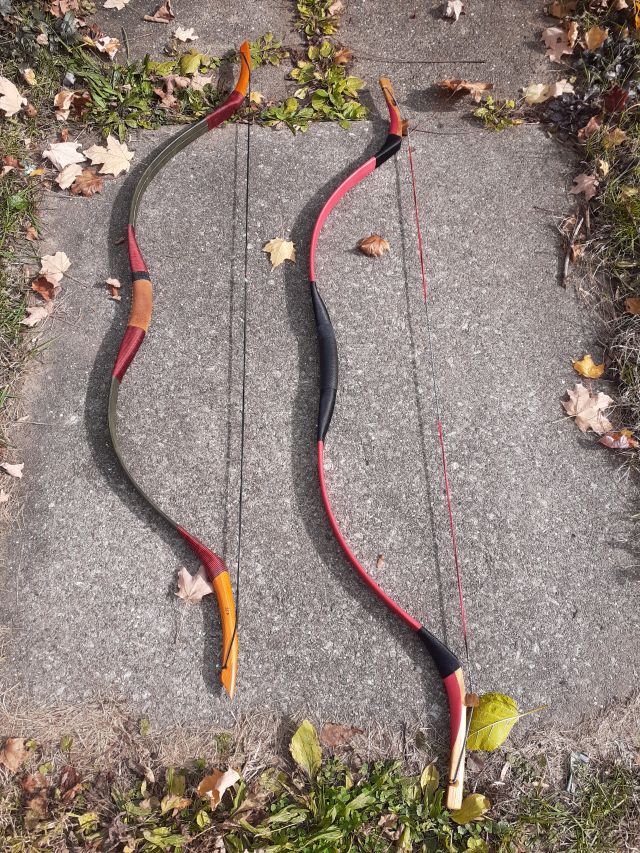
These are my two bows. The one on the left has a draw weight of 35 pounds at 28" (my draw is 29-1/2" making the draw weight closer to 38 pounds for me), and the one on the right pulls 50 pounds (53 pounds for me).
*Arrow and Target-making*
Aside from kite-flying, archery may be the only thing I do for its own sake. Every other hobby or pastime - from my martial arts to my ham radio - has some "practical" purpose which I can more-or-less articulate. Archery isn't like that. I don't hunt. I'm not keen on reenacting or keeping any sort of "living history" tradition alive. And I'm not a "prohibited person" so if I need a ranged weapon, that's what guns are for.
Shooting arrows at targets, therefore, is for the enjoyment, the excitement of learning, and the challenge of mastery. It scratches the "Let's Go To The Range" itch while being quieter, less expensive (relatively), and just as challenging & fun as poking holes in paper at 200 yards with an old mil-surp bolt-action rifle or muzzleloader.

These are my two bows. The one on the left has a draw weight of 35 pounds at 28" (my draw is 29-1/2" making the draw weight closer to 38 pounds for me), and the one on the right pulls 50 pounds (53 pounds for me).
So here I am presently conditioning myself to a 50-pound bow, knowing that it is not going to be my last one - God willing and the creek don't rise. I've also begun assembling things for arrow construction and maintenance, such that I can make whatever sorts of arrows I please.
Elsewhere on the Rubicon I've recommended many of Peter Dekker's excellent articles on Manchu archery (the style I do) for those who've honored me by asking for more information. Most recently, I found myself reading this one: http://www.manchuarchery.org/content/five-tiered-target.
It's about a target - more specifically, a target and the special arrows needed for it - whose aim is to train not only good aim but a clean release and a straight arrow path.
It consists of several concentric rings, held together by nothing but friction. The arrows are tipped with blunt, flat-headed or slightly conical, whistling heads. The point of the "game" is to knock the bullseye out without knocking any of the other rings out. This is harder than it at first appears. Not only does the archer need to hit the bullseye, he or she needs to hit it cleanly enough that the arrow pushes it - and only it - out rather than glancing off or knocking other rings out, as would happen if the arrow weren't traveling straight at it. This is even more challenging at shorter ranges, considering the flexing the arrow naturally does as it leaves the bow, also known as the "archer's paradox." But as the Manchus favored bows designed for greater power at short ranges, this is exactly the sort of contest they'd go in for.
It's a clever target that can manage to detect "B.S. bullseyes."
As you can see from the article and the photo series toward the end of the article, a modern version of the target itself is easy enough to make with foam, twine and bits of colored cloth. Field points or broadheads will not do - blunt tips are called for, and that's where I decided my arrow-making is going to begin – I resolved to make up some whistling arrows.
Amazon sells whistling arrowheads which are similar in size and shape to historical examples, which I like only because they're more aesthetically appealing. I don't know what they sound like but if they're anything like the videos of all the different whistling arrows I've seen, the whistle is delightfully blood-curdling, especially if one imagines being downrange of it.
Then I made up this interesting target:
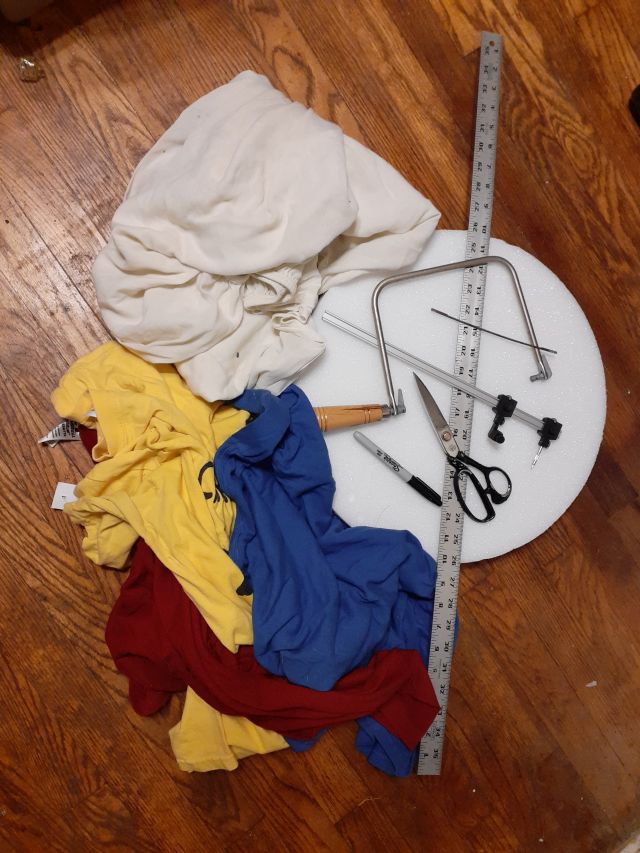
These are the components and tools I used to make the target up. It's two 16" circles of craft foam spray-glued together, wrapped in colored cotton – in this case, t-shirts from Goodwill. While I have a nice bow compass, you can make your own with a ruler, a nail, a Sharpie and two rubber bands.
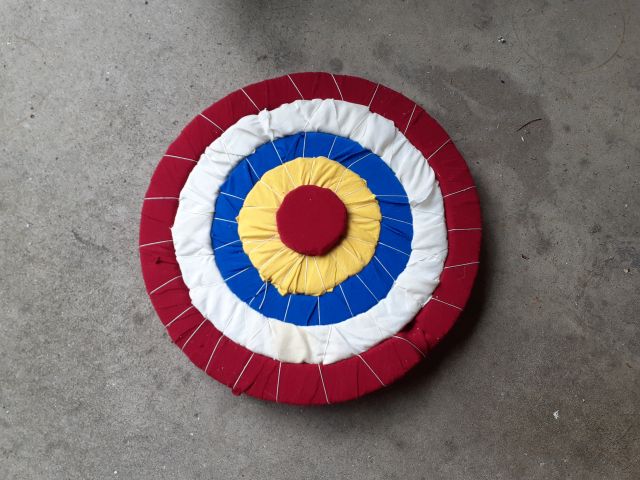
The finished target. Has a sort of carnival-game appearance. Between the photos and the article linked above, you shouldn't need any additional explanation making it. It's pretty intuitive.
I'm glad I landed on that article - it's a clever idea, looks like fun, gives purpose to my arrow-making and the end result teaches an important skill for good archery.
Learning to make arrows has the same crafty appeal to me as learning to make paper cartridges for my muzzle loader did last year. One ammo can's worth of paper cartridges turns out to be nearly a lifetime supply.
It's not the same with arrows. Sure, you usually need far fewer but even if you only have one bow, you should have at least a few different types.
Pursuant to this, I've made a half-dozen whistling arrows. They're to be used with the target described in the essay on the "Five-Tiered Target" above.
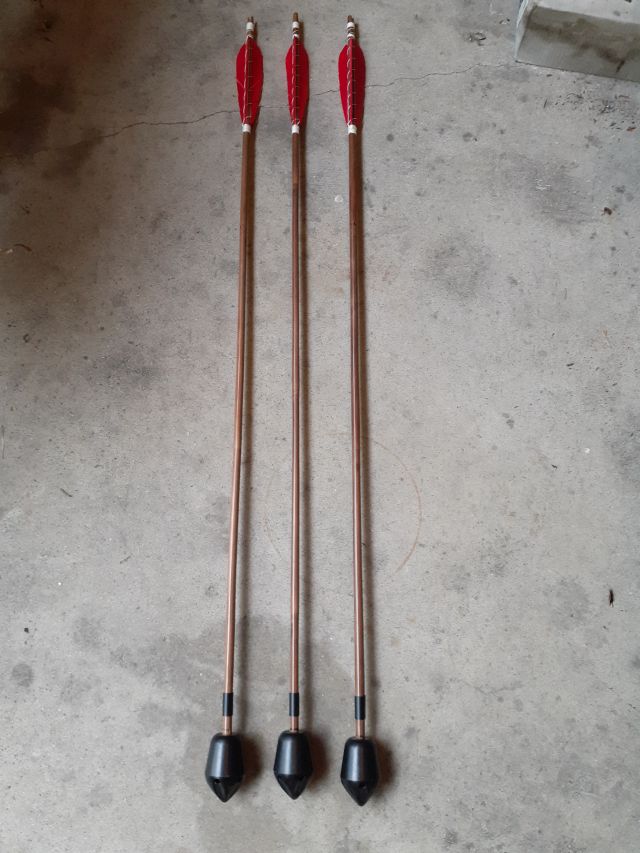
Three of the six arrows I made
There is nothing "historical" about what you see here. The head is plastic, the shaft is bamboo, the fletchings are much shorter than on Manchu arrows (5 inch turkey feathers, as opposed to the 10" or longer stork, eagle or vulture feathers typical of Manchu arrows), thread binding like mine is relatively rare in east Asia - they usually used silk thread in addition to hide or fish glue - and the electrical tape used as a "draw index" is likewise anachronistic.
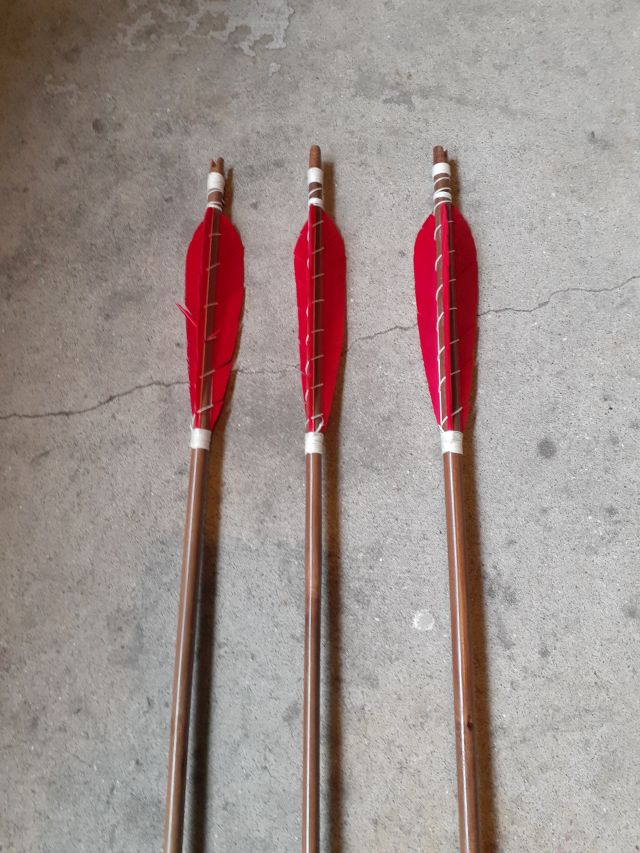
Closeup of fletching
On one arrow (not pictured), I used linen thread such as one would use in leather work. It's very strong and fit for purpose, but extremely difficult to work with. The remainder were bound as shown in the photo, using thin nylon twine that was run through a block of beeswax, compliments of some very generous Rubies. This proved much easier - 10 minutes of relatively easy binding per arrow, rather than the 40 minutes of fumbling and struggling with the linen.
In addition to the goal of making the arrows to use with the target I've discussed up-thread, this project was mostly for me to learn how to assemble arrows. Like any ancient skill, there's a knack to it, but it's relatively easily learned.
There are a few additional skills to learn if I want to make VERY good and attractive arrows: some of the intricacies of nocking, cutting my own fletchings from un-trimmed feathers, mounting tanged arrowheads in a bored-out shaft as opposed to gluing socket heads in, and so on. A couple feather-cutting templates are already on their way and I have a few things I would like to make - a "spine" measuring apparatus, a better arrow-straightener, and a fletching jig https://www.instructables.com/fletching-emplumadora for feathers too big to fit on the jig I learned with. This first one still has use, because my present arrows and all of Emily's still use common 5-inch feathers, which it's made to accommodate.
And there are a few things I don't expect to do, such as forge my own arrow heads or make my own shafts or thumb rings. The juice just isn't worth the squeeze - I can buy pre-made shafts and points and still feel like I've actually accomplished something more than just going shopping.
At the threshold is buying or making a Flemish-twist string jig for the bows. Good strings are so cheap and they arrive so quickly that making my own is right on the cusp of worth it/not worth it.
But it looks like I need never buy another finished arrow (and wait forever for the d@mned things to arrive) again. This alone makes the entire undertaking worth it. As much as Amazon and their ancillary businesses are a miracle of modern commerce, I'd still rather not wait a month or two for something like a batch of arrows to come all the way from China via container ship.
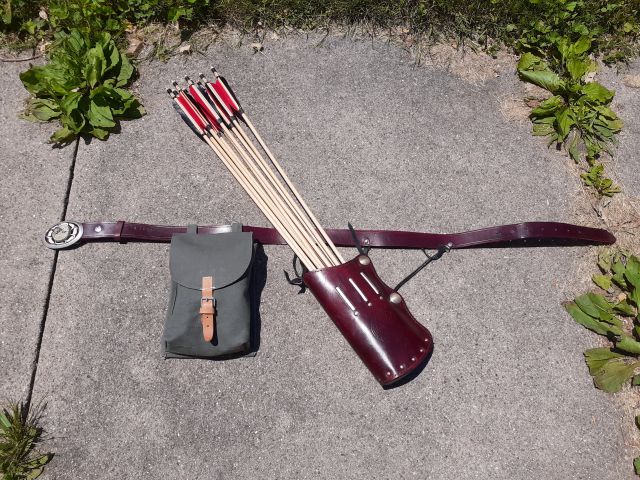
I'm old enough to have nice things
I've already made a belt for the quiver (dyed to match), but that's a different skill set altogether.
GVI
www.alpharubicon.com
All materials at this site not otherwise credited are Copyright © 1996 - 2021 Trip Williams. All rights reserved. May be reproduced for personal use only. Use of any material contained herein is subject to stated terms or written permission.